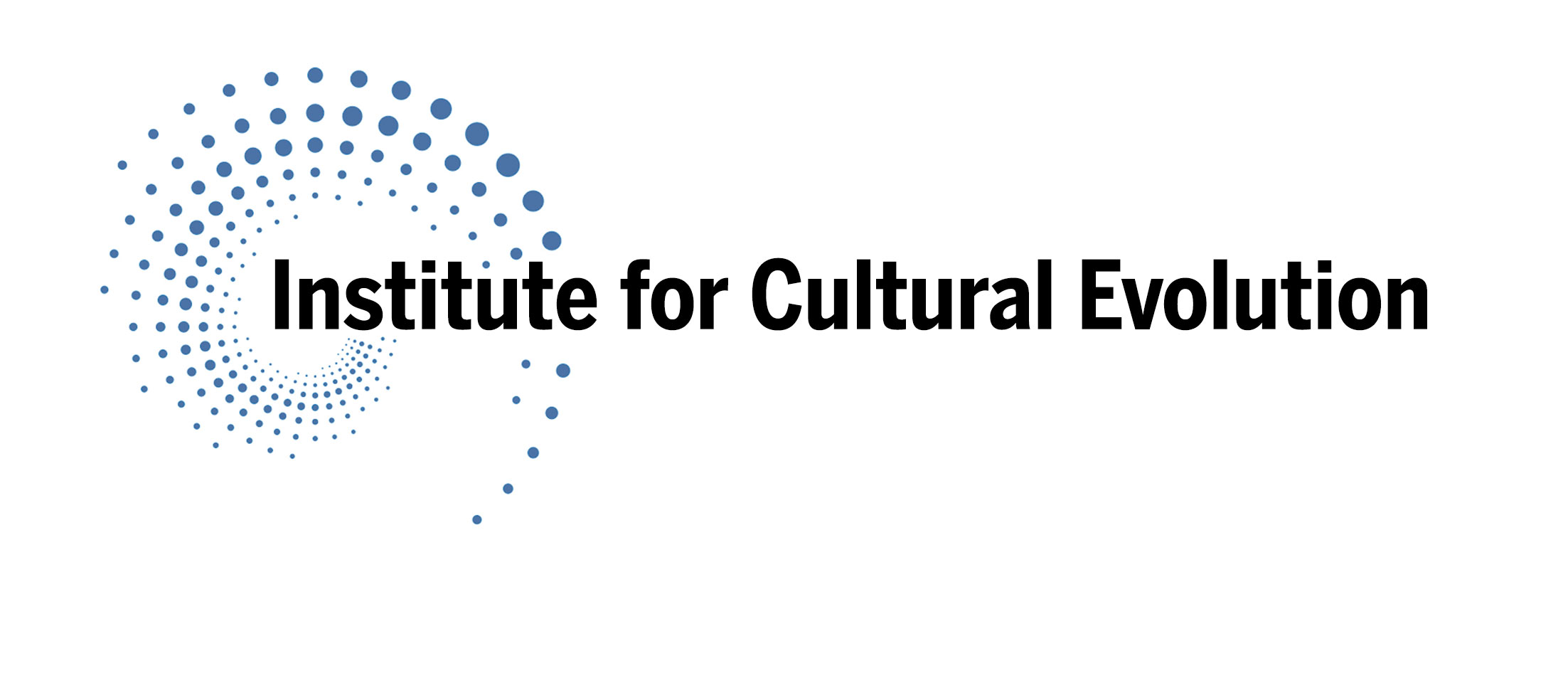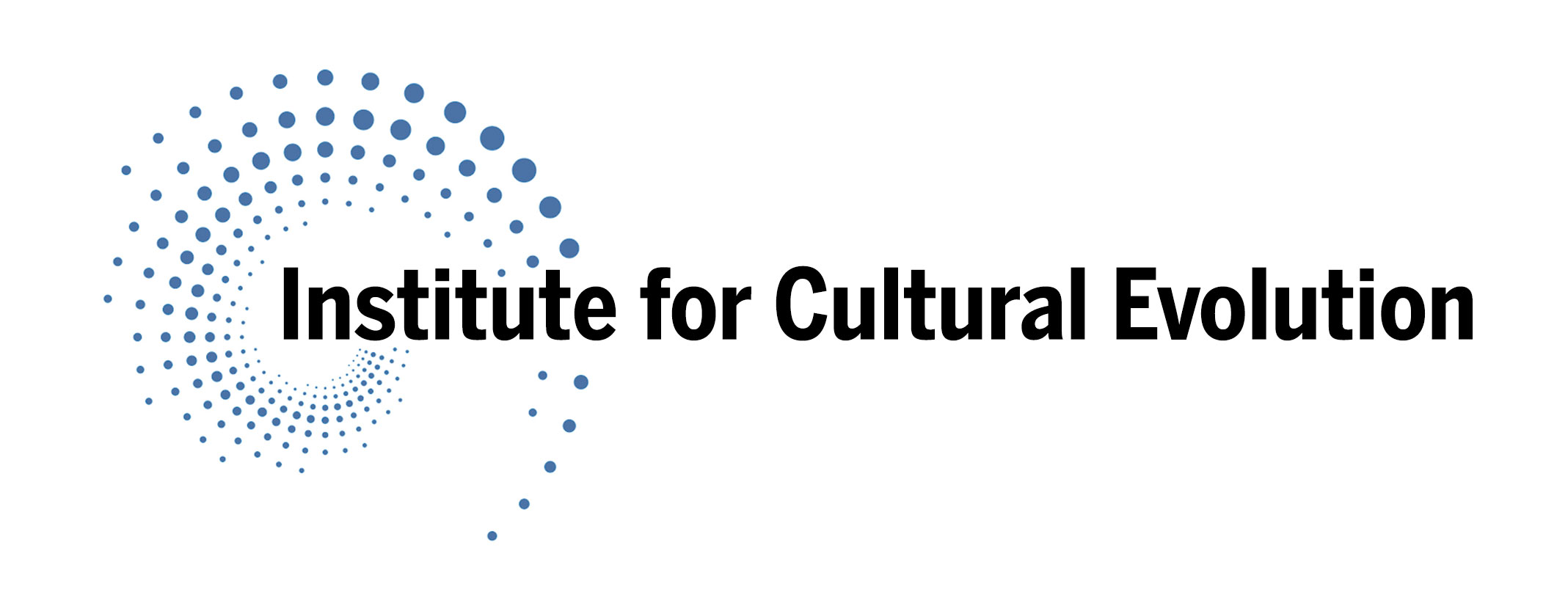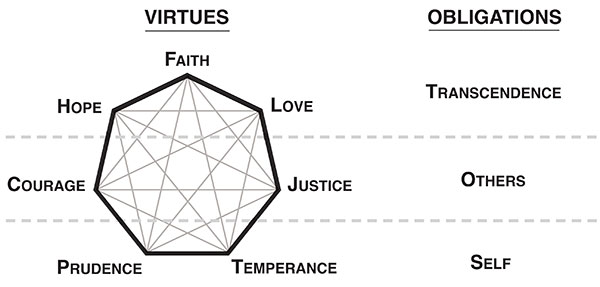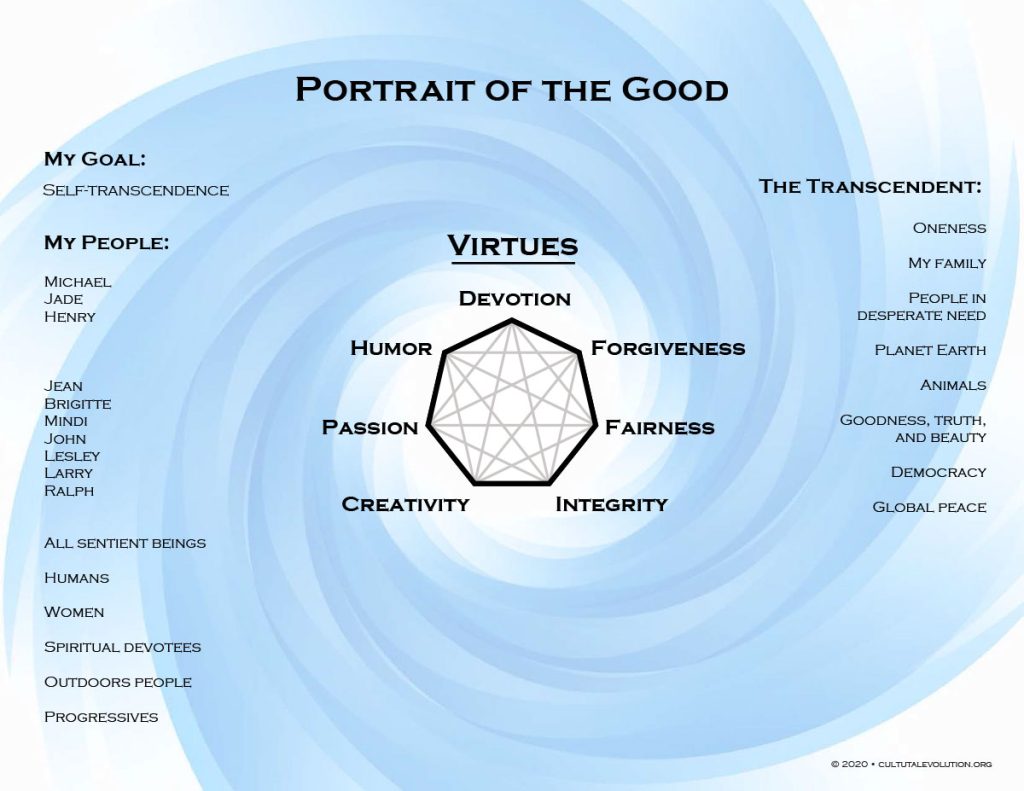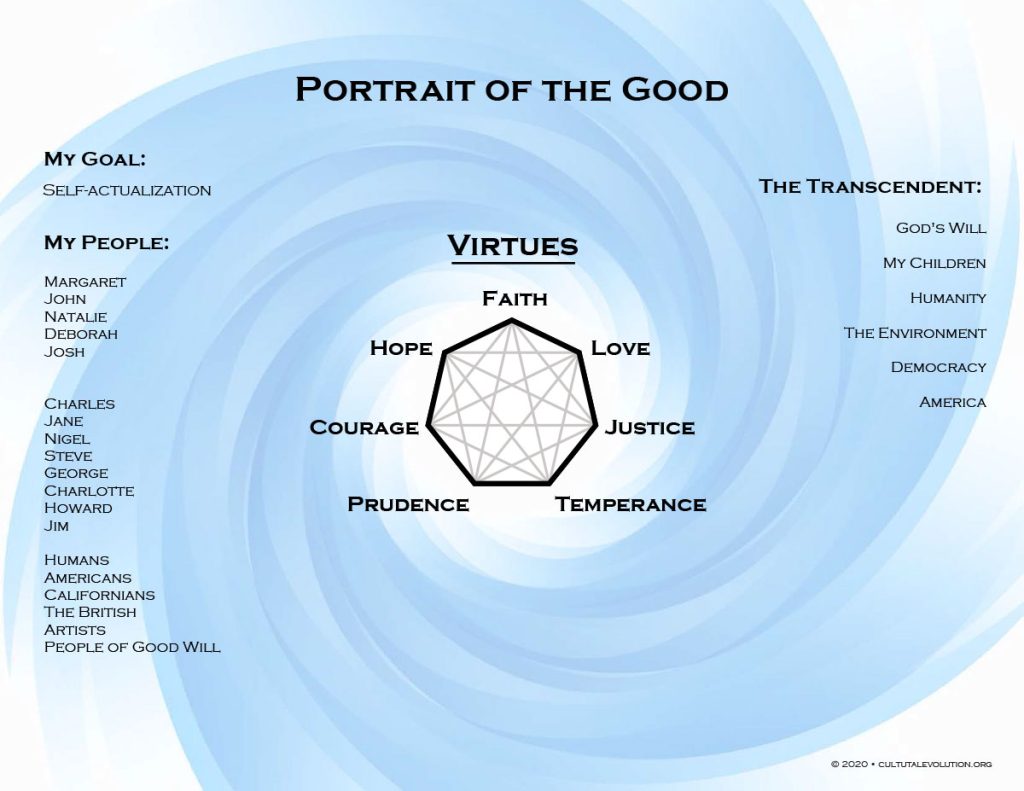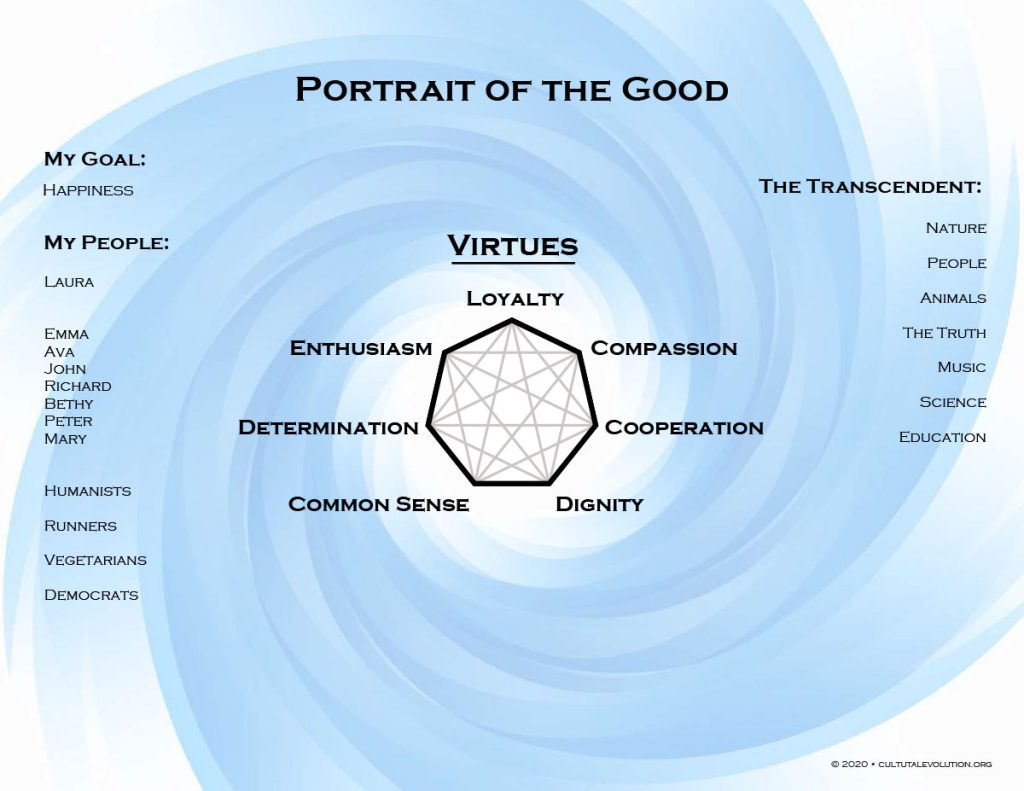Developmental Politics – Book Excerpts
Selected Excerpts from Developmental Politics by Steve McIntosh
Tracing the Development of the Progressive Postmodern Worldview: 8 page excerpt from Chapter 3
Reaching Political Agreement Through Values Integration: 2 page excerpt from Chapter 4
Evolving Our Understanding of the Good: 2 page excerpt from Chapter 5
A Transcendent Vision of Progress: 3 page excerpt from Chapter 9
Preface:
I’m a first-generation American. My parents immigrated from England and Australia in the early 1950s because it seemed to them that America was the center of the world, and they wanted to be part of it. So I was taught from a young age to be grateful for my American citizenship and to not lose sight of the importance of this unique nation. Although my patriotism is now more nuanced than that of my parents, who were ardently allegiant to their adopted county, I still care deeply about the fortunes of American democracy.
Although America is plagued with abundant problems and challenges, most of these problems have pragmatic solutions that are within our power to implement. Almost none of these solutions, however, can be realized within our current political environment. Our frustrated, stymied, stalemated, and hyperpolarized political process is stuck in its tracks, and this gridlocked condition is now beginning to cause our social regression. Hyperpolarization is really the mother of all our problems because very few of the serious challenges we face can be adequately addressed until we ameliorate the fractious and frozen state of our body politic.
As we will consider in the pages ahead, hyperpolarization is not a problem that can be solved under our current cultural conditions. The only way to ameliorate this “wicked problem” is to effectively grow out of it. This book accordingly explores the broadened perspectives and emerging methods that can help American culture evolve into the next phase of its historical development. The good news is that the daunting problem of our dysfunctional democracy is creating the developmental pressure we need to “think anew and act anew,” as Lincoln famously said. Although further regression is certainly a real possibility, the fractured state of American society also has the potential to catalyze a cultural renewal that can lead to a new era of political cooperation and progress. In other words, the difficult work of overcoming hyperpolarization can actually lead to a renaissance in American culture.
Throughout my life I’ve been fascinated with the times in world history that witnessed renaissances—periods of cultural florescence that brought about more advanced forms of civilization. My careful study of these renaissances eventually led me to an emerging perspective on cultural evolution known as integral philosophy.1 And since the year 2000 integral philosophy has been the primary focus of my working life. This innovative body of thought sheds new light on the intersection of science and spirituality, and the three previous books I’ve written in the integral genre have concentrated mostly on the spiritual side of this philosophy. But in addition to its illumination of spiritual questions, integral philosophy is also highly relevant to politics.
Recognizing the political potential of this new philosophy, I felt moved to try to use its insights to help improve America’s broken democratic process. Beginning in 2012 I joined with some colleagues in the integral movement to found a think tank dedicated to applying this emerging “developmental” perspective to America’s political challenges. This think tank, named the Institute for Cultural Evolution, focuses on political problems that are either being caused or exacerbated by America’s ongoing culture war. As will become clear as we proceed, the think tank’s integral perspective attempts to position itself “outside and above” America’s existing partisan factions, which means that its political stance is neither left, nor right, nor centrist. Besides myself, the leaders of the Institute for Cultural Evolution now include: Whole Foods founder and coauthor of Conscious Capitalism, John Mackey; education entrepreneur and host of The Daily Evolver podcast, Jeff Salzman; journalist and author of Evolutionaries, Carter Phipps; serial tech entrepreneur John Street; and philosophy professor and coauthor of Integral Ecology, Michael Zimmerman.
Initially, the Institute focused on the problem of global warming. By 2012 climate change had become a highly partisan and deeply divisive issue in American politics, so this seemed like a good place to start. But after working on the cultural dimensions of climate change for close to two years, it became evident that America’s failure to address global warming was actually the result of another wicked problem—the problem of hyperpolarization. And this problem has been the main focus of the think tank ever since.
Between 2014 and 2016 the Institute convened a series of small invitational conclaves on hyperpolarization which brought together influential thought leaders on both the left and the right. The participants in these conclaves included prominent luminaries such as social psychologist Jonathan Haidt, political scientists Thomas Mann and Norman Ornstein, controversial scholar Charles Murray, The Breakthrough Institute’s Ted Nordhaus, conservative pundit Margaret Hoover, Reason magazine’s Nick Gillespie, MoveOn.org founder Joan Blades, Log Cabin Republicans founder Rich Tafel, and Daily Beast editor-in-chief John Avlon, to name a few.
In addition to convening conclaves, we also gave lectures, wrote scholarly papers, published op-eds, received philanthropic grants, and gained recognition in numerous mainstream media outlets. Yet by the summer of 2016 my colleagues and I realized that we needed a substantial book that would explain our developmental perspective and demonstrate its potential to help ameliorate America’s dysfunctional political condition. The writing of this book has accordingly been my full-time job for most of the last three years. Developmental Politics distills our learning and describes the new approach to politics and culture we have worked out over the course of this past decade.
The purpose of this book, as well as the larger movement for developmental politics overall, is to help American culture evolve beyond its hyperpolarized condition. While this goal may at first seem unrealistic or overly idealistic, all of my arguments and observations are made with a pragmatic focus in mind. As Otto von Bismarck famously observed, “politics is the art of the possible, the attainable—the art of the next best.” As I will argue, under our contemporary political circumstances, achieving the “next best” involves expanding the scope of what we can value and thereby coming to view our political opponents more sympathetically. In other words, because our political problems are being caused primarily by the larger cultural discord that currently plagues our society, working to overcome this discord by evolving our culture is actually the most pragmatic thing we can do.
The work of evolving American culture begins by shining a fresh light on the bedrock values that are at the root of our political problems. While this concentration on values is necessarily philosophical, under our hyperpolarized conditions few things could be more practical than an improved philosophy of cultural evolution. Improving our theory of change is crucial because, as Einstein famously observed, it is your theory that determines what you can see.
The pragmatic applications of developmental politics are accordingly woven together with its philosophy of cultural evolution. In order to make this philosophy accessible to the general reader, the book is divided into two parts. Part I describes a new “politics of culture” that looks beyond the confines of Washington D.C. in an effort to better understand the conflicting worldviews that are behind our contemporary culture war. After analyzing the values-based worldviews that are driving cultural change, Part I concludes by introducing a method for overcoming hyperpolarization. This novel method promises to make progress where previous attempts at political mediation have failed.
In my discussion of the political philosophy of developmental politics, I will provide examples, but I won’t spend much time discussing political personalities or offering detailed solutions to specific issues. Such an approach would only leave us bogged down in the stalemated duopoly we need to escape. Almost every current political issue is already so highly polarized that it is nearly impossible to even discuss these issues without appearing to come from either the left or the right. The polar forces that are pulling us apart have become so strong that finding a stable political “center” is like trying to find the center of a strong magnet—the opposing magnetic forces inevitably pull us to one side or the other. This is why we need a perspective that doesn’t try to position itself in the middle of a perceived linear continuum between left and right. In order to grow beyond our contemporary political impasse we need an expanded perspective that is effectively positioned outside and above our contemporary cultural battleground.
Part II then goes deeper into the political philosophy that provides the ideational foundation of developmental politics. This philosophy offers a broad and inspiring vision for our collective way forward by reframing the idea of progress, and by advancing a new approach to generating positive political will. Although it is inadequately appreciated, political philosophy has in fact played an indispensible role throughout the history of American democracy. In order to function properly, all democracies need a vibrant and discerning political philosophy that can keep them in touch with their founding values and serve as a moral compass in their ongoing attempts to maintain justice and promote social progress. And given the extent to which American politics have gone off track, the dysfunctional state of our political process itself points to the need to update our political philosophy to account for the radical social changes that have occurred in America over the last fifty years. It is thus my sincere hope that the philosophy of developmental politics can make a useful contribution to the contemporary body of mainstream political thought.
Most Americans continue to love their country and care deeply about its future. But under our current political conditions, many of us feel powerless to effect meaningful change. In response to this dilemma, this book promises to show how we can evolve beyond the hyper-partisanship that is pulling our country apart. As we will see, the evolution we require must include both the personal growth of a critical mass of our citizens, as well as the collective maturation of our culture as a whole. Fostering positive growth at both of these levels simultaneously is thus the mission of developmental politics.
Preface Endnote 1:
1. Integral philosophy is a broad philosophy of evolution that focuses on the structures and larger meanings behind the evolutionary development of humanity. This philosophy of evolution begins with G.W.F. Hegel, but it is not a strictly Hegelian philosophy. Other notable philosophers who have attempted to understand the evolution of consciousness and culture, and have thus contributed to integral philosophy, include Henri Bergson, Alfred North Whitehead, Pierre Teilhard de Chardin, Sri Aurobindo, Jean Gebser, Jürgen Habermas, and Ken Wilber. Although the word “integral” is often associated specifically with the work of Wilber, this body of thought is much larger than Wilber’s philosophy alone. The use of the term “integral” to refer to this larger philosophy of evolution can be traced back to the first half of the twentieth century in the work of Gebser, Aurobindo, and in the writing of Harvard sociologist Pitirim Sorokin. And interestingly, although there is a remarkable degree of overlap among these three early integral philosophers, each of these authors independently chose to label their thinking “integral” even though they were not aware of each other’s work. Then later in the 1980s, Wilber adopted this term to refer to his work as well. Overall, I respect Wilber and have benefited from his writing, but as explained in note 9 to chapter 4, and further in appendix A, my interpretation of integral philosophy differs from his. While I too describe my thinking as “integral,” I am not a “Wilberian.” For an intellectual history of integral philosophy see: Steve McIntosh, Integral Consciousness and the Future of Evolution (St Paul, MN: Paragon House, 2007), chapter 7, “The Founders of Integral Philosophy,” pp. 153-197.
Excerpt from Chapter 3: Tracing the Development of the Progressive Postmodern Worldview
As discussed in the last chapter, mainstream political commentators and social scientists do not have a viable strategy for ameliorating America’s gridlocked politics because they fail to fully grasp how or why the disruptive culture of postmodernism has become so powerful. Like all historically significant worldviews, postmodernism is attempting to remedy the shortcomings and pathologies of the worldview that preceded it, which in this case is modernism. The postmodern worldview has thus been instinctively striving from its beginnings to overcome the perceived hyper-individualism of modernity by reclaiming a new communitarian ethos—a post-traditional form of collective solidarity based on the tenets of a new system of values. Tracing the history of postmodernism’s ongoing struggle to transcend modernity will therefore contribute to our understanding of the social and cultural forces that are currently paralyzing America’s democratic process.
According to the analysis of Deirdre McCloskey and other economic historians and political scientists, for a relatively brief period between 1789 and 1848, in Western Europe and America the newly ascendant worldview of modernity was celebrated by elites and commoners alike as a moral triumph. Liberty, equality, and fraternity became the watchword of the times, and the new freedoms afforded by liberal values—“the Rights of Man”—were widely acclaimed as the marvelous new order of the age.
During this honeymoon of modernism, many traditionalists continued to view it with suspicion. But even from its very beginnings modernity’s secular-rational worldview attracted critics who were not traditionalists. Stirrings of discontent within modernist ranks began with the poets and writers of the Romanticism movement who reacted to a fading faith in God by attempting to rediscover some form of ultimate meaning in nature and in human emotion. Yet for the most part, artists and intellectuals in the first half of the nineteenth century welcomed the innovative and commercial spirit of modernity as a fresh wind of progress.
The Revolt of Modernity’s Artists and Intellectuals: 1848 to 1968
While the cultural honeymoon of modernity would last at least until the disillusioning calamity of World War I, strong opposition to modernism’s increasingly evident pathologies began to appear around the pivotal year of 1848. By the mid-nineteenth century many of modernity’s elite thought leaders had become critical and even disdainful of what they saw as the vulgar pursuits of the bourgeoisie. Modernism’s driving engine of free market capitalism accordingly became the focus of an “intellectual organization of political hatreds.” The most prominent figure in what is now recognized as the “revolt of the artists and intellectuals” was Karl Marx, whose Communist Manifesto was first published in 1848. But this loss of confidence in modernity cannot be conflated with the rise of Marxism. Other influential writers such as Charles Dickens and Thomas Carlyle expressed their own versions of dismay at the depredations of the industrial revolution.
In the period between 1848 and the similarly pivotal year of 1968, a significant portion of highbrow society in Europe and America, and nearly all of modernity’s cultural elites, took a dim view of what they saw as “the evil of profit, the curse of materialism, the insincerity of advertising, the scandal of excessive consumption, the irreligiousness of commercial dealing, the corruptions of corporations, the ruination of the environment, [and] the inevitable poverty consequent on a system of market capitalism …” Even as millions achieved middleclass prosperity and technological innovation continued to advance at staggering speed, the flourishing scientific and commercial civilization brought about by the modernist worldview was viewed from within by many of its best and brightest citizens as morally bankrupt.
There were, of course, many good reasons to hold modernism in contempt. Beyond the perceived vulgarities of capitalism, the rapacious colonialism of the nineteenth century, followed by the devastating world wars of the twentieth century, provided seemingly ample justification for its rejection.
However, from the perspective of developmental politics, which focuses on the competing value systems that drive the evolution of culture, there was another, deeper reason why many sensitive thinkers for the last hundred and fifty years have found modernity to be intolerable. Although it was rarely clearly articulated or even fully realized by the contrarian artists and intellectuals themselves, the liberal values of modernity were deemed unacceptable because they lacked a strong vision of the transcendent—a form of ultimate meaning that is more important than the needs of the individual self.
Modernity’s individualistic ethos was focused on liberating its citizens and protecting them from the oppressive dictates of the collective. But because classical liberal values were chiefly
concerned with the sovereignty of the individual self, this made it seem as though
self-interest was modernity’s only guiding
principle. And this helps explain why many
of the thought leaders of Western civilization found the modernist worldview to be
morally repugnant.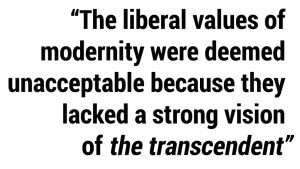
Every version of the traditional worldview past and present employs a robust concept of the transcendent to serve as the focal point of its moral system. Notions of God’s will or “the one true way” provide the heading for traditionalism’s progress, and the very reason for its existence. Indeed, all socially viable moral systems identify some worthy object of ethical obligation that defines a greater good for which the sacrifice of self-interest can be justified. And in practically all traditional societies this ethical object is found in devotion to some kind of transcendent Deity. But as modernity escaped the bonds of Christianity’s medieval political power during the Enlightenment, it also became simultaneously separated from the law-giving moral power of the transcendent itself. Even though most modernists continued to believe in God, and even though large portions of the population in both Europe and America remained loyal to traditional values, the unifying power of traditionalism’s moral system was increasingly delegitimized as modernity became the dominant worldview of the West.
Although the unifying authority of traditionalism’s moral system had been gradually decreasing since the Enlightenment, the publication of Darwin’s Origin of Species in 1859 dealt a death blow to traditional Christianity in the minds of many elites. Traditionalism’s claims on political power had been largely repudiated during the eighteenth century, and then in the nineteenth century science overturned traditionalism’s foundational creation story. Yet even though traditionalism’s moral authority had been substantially discredited in the minds of many elites, Christianity continued to provide the default moral system that underpinned much of Western society through at least the first half of the twentieth century. However, as discussed in the next section, the year 1968 marked the beginning of the end for the mainstream cultural truce between traditionalism and modernism.
At a deep, and in many cases unconscious, cultural level, the gradual de-legitimization of traditional morality throughout the nineteenth and twentieth centuries precipitated the search for a substitute ideal of transcendence. With the justifying authority of God’s natural law increasingly absent, modernists needed a new way to ground their notions of justice and morality in something higher—something more worthy than self-interest alone. “Modern Westerners rejecting God found other gods, in will or despair or history or spiritualism or science or the environment.” But among all the candidates for a new moral object of ethical duty, “the people” became the primary stand-in for a religious concept of the transcendent. For many modernists, the secular love of others seemed to suffice as a worthy cause on which to ground their morality.
However, as modernity became untethered from its traditional moorings, this seemingly benign devotion to the collective morphed into two dangerous, and in hindsight predictable, social trends. Communism and ultra-nationalism, each in their own way, became focal points of this new devotion to the quasi-transcendent cause of the people. For the communists, this new object of ethical concern was defined as the proletariat masses who had been oppressed and exploited by the bourgeois ruling class. And for the fascist ultra-nationalists, the cause of the people was defined largely in ethnic or racial terms as the collective will of “the Volk.” The religious fervor with which both communists and ultra-nationalists pursued their newly framed devotions to the people eventually led, of course, to the titanic clash of the Second World War.
The catastrophic failure of both communism and ultra-nationalism during the twentieth century provides strong evidence that the worldview of modernism is not capable of generating a functional moral system of its own. Lacking the constraints and civilizing influence of traditional morality, both communism and ultra-nationalism, although originating within modernity, ultimately devolved into malignant forms of pseudo-modernity. And although communism and fascism have been defeated for the most part, pseudo- modernity, defined as a society that has mastered modernity’s scientific technology but has failed to embrace modernity’s liberal values, continues to plague humanity into the twenty-first century.
Even though communism would not collapse until 1989, by the 1960s modernism’s failure to provide a free-standing, post-traditional moral system of its own had become evident to many in the West. While a new moral system founded on the vision of an exalted collective humanity still seemed like a hopeful possibility, it was becoming clear that this new moral agreement structure could not take root within the individualistic worldview of modernity itself. Attempts to substitute humanity for God while still remaining within a modernist value frame inevitably led to pseudo-modernity. Therefore, in order to safely establish “the people” as a new transcendent ground of moral obligation, it would be necessary to break out of modernist culture altogether.
Yet although the morality of modernity had been called into severe question by the events of the first half of the twentieth century, following World War II and before the upheavals of the Sixties, America’s national unity and revitalized prosperity resulted in a kind of golden twilight for the cultural truce between modernism and traditionalism. The brief interlude between 1945 and 1968 was marked by strong social solidarity among Americans and a functional political consensus between Democrats and Republicans. This period of consensus was brought about by traditionalism’s temporarily renewed influence. However, for reasons outlined in the last chapter, the post-war armistice between the individualistic liberal values of modernity and the communitarian religious values of traditionalism could not last. Their political partnership had become rationally incoherent.
Prior to the mid-Sixties, the intellectual and artistic opponents of modernity had remained a small, culturally elite group. But as the baby boom generation came of age, many found the message of Western civilization’s critics appealing. In light of the horrific events of the twentieth century, this new generation was persuaded en masse that traditionalism had been delegitimized by science and philosophy, and that modernity had been discredited by war and the degradation of the environment. For this sensitive post-war generation, the prevailing establishment truce was no longer tenable, so the quest for an entirely new worldview seemed to be the only viable option.
Postmodernity Is Born As a Distinct Worldview
Even though they had positioned themselves as modernity’s cultural critics, the artists and intellectuals who rejected bourgeois liberal values prior to the Sixties nevertheless remained embedded within modernist culture. Marxists, for example, viewed social change primarily in economic terms and were committed to materialist metaphysics and atheism. But beginning in the 1960s, America’s middleclass youth, who already enjoyed practically everything modernity had to offer, began to feel a sense of collective discontent with the society they had inherited. It was thus from the heart of modernity’s most successful expression up to that time—the prosperous American society of the early Sixties wherein the cultural truce between modernism and traditionalism still prevailed—that postmodernism would first emerge as a historically significant worldview in its own right.
Just as the advent of modernity in the Enlightenment is now recounted with a standard narrative (described in the last chapter), the cultural changes that began in the 1960s also have a similar standard narrative. By this telling, the baby boom generation had been spoiled by privilege and had become restless. This led to an indulgent revolution of youthful idealism, fueled by drugs and a sense of liberation from oppressive traditional social norms. According to this standard narrative, the turbulent Sixties made society incrementally more tolerant and achieved some permanent social changes, but as the hip- pies matured, most were eventually assimilated back into bourgeois society. Indeed, this self-serving modernist account of a “failed revolution” and the subsequent demise of Sixties idealism seemed to be confirmed in the 1980s as Ronald Reagan and a re-emergent religious right temporarily restored the political authority of the modernist-traditionalist cultural alliance.
However, the standard narrative that paints the countercultural emergence of the Sixties as merely the folly of self-indulgent young baby boomers who have since grown up is merely wishful thinking on the part of modernists. The contemporary circumstances of the early twenty-first century reveal that the rejectionistic spirit that began in the Sixties has not been subsumed or assimilated within a continually growing modernity. Rather, the postmodern worldview has now become a politically significant cultural force that is supplying much of the existential discontent which continues to fuel America’s ongoing culture war.
Although artists and intellectuals had been voicing their discontent for over a century, before the emergence of postmodern culture in the Sixties, their criticisms of modernity remained mostly within elite circles. And as noted, despite their suspicions, these critics were themselves culturally modernist in many important respects. But as the postmodern worldview began to emerge, anti-modernist opinions took on a new character and became widely democratized. As a result of powerful new forms of countercultural music and fashion, together with the worl dview-shattering experience afforded by psychedelic drugs, the personal rejection of a modernist cultural identity was made attractive and exciting to large numbers of people. Moreover, the alternative forms of spiritual culture that blossomed in the Sixties seemed to offer the enticing promise of a fresh, emancipative lifestyle that could leave the rat race behind.
These newly minted counterculturalists were politically progressive and decidedly leftist, but their politics constituted a
new left. 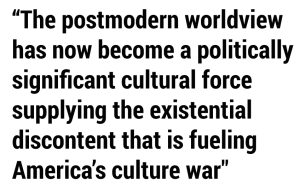 Whereas the old socialist left had
been stoic and direly serious, this new postmodern left was more irreverent and playful (at least at the beginning). The new left inherited the moral righteousness of the civil rights movement, which it then combined with the youthful spirit of the anti-Vietnam war movement to create the political consciousness that would eventually develop into contemporary forms of postmodern resistance.
Whereas the old socialist left had
been stoic and direly serious, this new postmodern left was more irreverent and playful (at least at the beginning). The new left inherited the moral righteousness of the civil rights movement, which it then combined with the youthful spirit of the anti-Vietnam war movement to create the political consciousness that would eventually develop into contemporary forms of postmodern resistance.
By 1968, the cord that bound anti-modernist intellectuals and their followers to the seemingly inescapable culture of modernity had finally snapped. Just as modernity itself had originally broken with traditionalism in 1789 through the rallying cry of “liberty, equality, and fraternity,” postmodernity similarly declared its new-found freedom from modernity with the slogan: “turn on, tune in, drop out.”
As noted, however, by the late-Seventies the promise of the hippie movement had been largely co-opted by modernist culture. As the liberating music of the Sixties was superseded by disco and punk, hopes for the new “Age of Aquarius” faded, and many came to the conclusion that Sixties culture was merely a passing fad. But even as early postmodern culture became less visible within the mainstream, it continued to flourish in elite enclaves, most notably in academia and the entertainment industry.
Then after a period of relative quiescence in the 1980s during the Reagan years, postmodern culture witnessed a kind of rebirth in the 1990s. Although it was no longer merely a youth movement, the values of the postmodern worldview found fresh expression in a revitalized environmental movement and in a new push for diversity and multicultural inclusivity.
The ongoing vitality of postmodern culture was also nourished in the 1990s by the florescence of New Age spirituality. Youthful fascination with the mystique of Eastern religions and alternative forms of spirituality was a significant part of the counterculture from the start. But in the 1990s alternative spirituality experienced a boom as popular authors such as Deepak Chopra and Marianne Williamson rose to prominence, and this progressive form of spirituality became the publishing industry’s largest category by far.
And now, as postmodern culture continues to develop into the twenty-first century, its momentum is being quickened by the coming of age of the millennial generation. Millennials evince a strong affinity for postmodern values, as shown by their enthusiastic support for Bernie Sanders’ candidacy and by their staunch political correctness. While the postmodern culture of millennials is not identical to the original postmodernism of their baby boomer forebears, the worldview of progressive postmodernity nevertheless demonstrates tenacious intergenerational continuity.
Unlike traditionalism or modernism, contemporary postmodernism can be hard to pin down. Because of its inherent pluralism, and because it consists of many disparate cultural currents, it can sometimes be difficult to recognize as a coherent system of values. Yet like traditionalism and modernism, postmodernism engenders strong loyalty from those who make meaning using its perspectives. Moreover, the postmodern worldview defines who and what is valuable in ways that are clearly distinct from previous worldviews. As discussed in the last chapter, the influence of postmodern values can be seen in the increasing popularity of socialism, environmentalism, feminism, critical academia, and many other identifiable expressions of progressivism. Despite the diversity of views that are embraced by the postmodern worldview, what generally binds postmodernists together is their agreement regarding the abundant pathologies of modernism. Anti-modernism is thus the hallmark of practically all forms of postmodern culture.
Beyond the provision of political opinions and social norms, the distinctive culture of postmodernism gives its adherents a sense of cultural belonging. Postmodernists can usually recognize each other through their common styles of dress, by their scrupulous diets, and by their social associations. As will become increasingly apparent as our discussion continues, the postmodern counterculture that first emerged in the Sixties has now become a kind of counter-establishment—a politically influential structure of value agreements that can be compared and contrasted with modernism and traditionalism.
Postmodernism Is Founded on a New Communitarian Ethos of Sensitivity
… end of excerpt.
Excerpt from Chapter 4: Reaching Political Agreement Through Values Integration
America’s contemporary political dysfunction is a complex problem with many contributing causes and no straightforward solution. Yet at the same time, the problem is simple: Americans have become unwilling to compromise politically or otherwise agree with each other. And from this perspective the solution is unambiguous: we need to find new ways to agree.
In response to this challenge, this chapter describes the method of values integration, which is developmental politics’ primary strategy for building political agreement. First we consider why conventional methods for reaching consensus are not working. Then we focus on the actual locus of our national political discord: The conflict between bedrock values where the cultural battle is joined. Clarifying the bedrock values that are at the root of our political discord entails analyzing both the positive and negative features of America’s major value systems, as well as charting the fault lines and dynamic tensions that exist between each of these political positions. As I hope to make clear, within the very value conflicts that divide us there can be found points of interdependence. And it is by working with these interdependencies that the values integration method gains traction on the potential for agreement. After covering the basic outlines of this method, we then consider examples of the method in action to see how this approach is already working in the case of some issues, and how it can be expanded and pursued more deliberately with other political issues. The chapter then concludes with a discussion of the integrative perspective that is ultimately needed to effectively build agreement by integrating values.
The values integration method outlined in this chapter is connected to a larger suite of related “agreement technologies.” But these other methodological approaches to building agreement are more philosophical in nature, and will thus be considered in the context of Part II’s discussion of political philosophy. The basic method of values integration discussed in this chapter, however, serves as a pragmatic foundation for developmental politics’ overall approach to reaching agreement and building political will. Moreover, this foundational method ties together the discussion of worldviews in the first three chapters and accordingly provides a fitting culmination of Part I.
Conventional Proposals for Reaching Political Agreement
 Over the last ten years or so, a cottage industry of nonprofit institutions and think tanks has emerged seeking to promote respectful inter-party dialogue and political compromise. “Civil discourse” is the watchword of these groups.1 The idea being that if both politicians and ordinary citizens could only listen to each other and be more open-minded about common goals and potential solutions, we could move forward without rancor and incrimination. According to this strategy, by building channels of respectful dialogue between opposing camps, we can eventually overcome the artificially imposed divisions that keep us apart.
Over the last ten years or so, a cottage industry of nonprofit institutions and think tanks has emerged seeking to promote respectful inter-party dialogue and political compromise. “Civil discourse” is the watchword of these groups.1 The idea being that if both politicians and ordinary citizens could only listen to each other and be more open-minded about common goals and potential solutions, we could move forward without rancor and incrimination. According to this strategy, by building channels of respectful dialogue between opposing camps, we can eventually overcome the artificially imposed divisions that keep us apart.
This civil discourse strategy is hopeful and well-meaning, and bipartisan compromise is certainly good where you can get it. But after closely observing this method in real-life political contexts over the last few years, my sense is that it is only marginally effective at best. Overcoming our political impasse will not be accomplished by a better process; we must address the actual content of our disagreements, which are ultimately about values.
Another strategy being advanced to overcome political stagnation and persuade citizens to act prosocially in how they vote and consume comes from the fields of evolutionary psychology and behavioral economics. This approach includes the practice of “reframing conceptual metaphors” (advocated by George Lakoff), and “disentangling matters of fact from the cultural cognition of opposing group identities” (championed by Dan Kahan). The attempt to apply evolutionary psychology to politics also entails the crafting of subtle incentives and “gentle nudges to opt-in to the right choice,” as described by proponents of “libertarian paternalism” (such as Sunstein and Thaler).2 Like the civil discourse approach, this psychological-rhetorical persuasion strategy for building political agreement is also well-meaning. But in practice it can quickly become condescendingly manipulative and even disturbingly Orwellian in its implications. Because of its inherent deviousness, this approach is ultimately misguided. Increasing sympathy for a wider spectrum of values requires a persuasion strategy that is fundamentally transparent and sincere.
Yet another strategy for fostering political agreement focuses on campaign finance reform. Advocates of this strategy contend that the dominance of big money in politics is the primary cause of our gridlocked condition. These activists argue that the ideological purity demanded by large donors makes politicians unwilling to compromise or work with the other side. Passing legislation to curtail the outsized influence of oligarchs and corporations is thus seen as the best way to overcome hyper-partisan polarization.
While I will not deny that the outsized influence of money in politics is indeed problematic, I don’t believe campaign finance reform is a panacea for our democracy’s dysfunction. In fact, reforming our electoral system’s financial structure is itself a project that depends on the existence of political will that is clearly lacking under present conditions. In order to reform the “politics industry” in general, and the influence of money in politics in particular, we must first overcome the cultural barriers to political agreement that currently stymy any attempts at structural reform.
Moreover, the notion that our political system is now completely bought and sold by plutocrats has been called into question by the results of 2016. At least one positive outcome of Donald Trump’s election is how it has shown that our system is not completely controlled by money alone. Election results are not fixed or predetermined by an oligarchy; popular democracy is still powerful. And if voters have the power to sweep aside the political establishments of both parties and elect a reckless and unfit outsider, they also have the power to elect an extraordinarily innovative—even “developmental”—presidential candidate.
That being said, we cannot rely on the appearance of a magic candidate to solve our problems. As Plato understood more than two thousand years ago: “The states are as the men are; they grow out of human characters.”3 Therefore, in order to overcome the fractious and frozen condition of contemporary American politics, we need to improve and evolve the electorate itself.
The idea of overcoming our political dysfunction by changing American culture is, however, usually ruled out by advocates and pundits because they have no idea how to go about the process of fostering cultural evolution. Some commentators even argue that trying to change peoples’ values is disrespectful. But developmental politics does not seek to change the values people hold dear. Rather than trying to convert or replace existing values, this new approach seeks to expand the scope of what people are able to value. Simply put, we don’t want to erase or subtract peoples’ values, we just want to add to them.
Focusing on the Bedrock Values at the Heart of Our Political Disagreements
To grow out of our political dysfunction, we need to concentrate on the actual locus of the conflict: the bedrock level of values. This bedrock level of politics can be understood through an analogy with geological strata, as illustrated in figure 4.1. This graphic suggests that below the familiar levels of conventional political discourse and engagement, below the campaigns and party politics covered by the media, and even below the specific issues and interests that animate political factions, there lies a bedrock layer of foundational values.
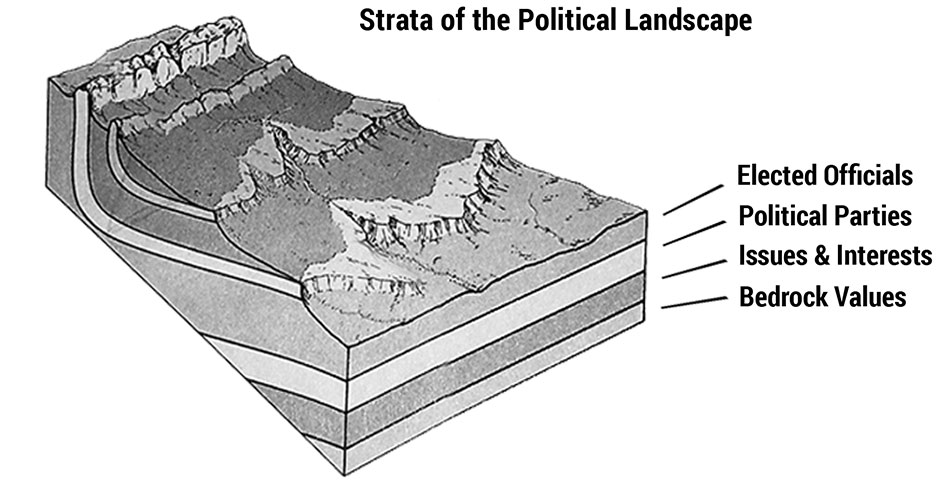
Figure 4.1. Levels of politics can be compared to layers of geological strata
Even though this bedrock layer is apparently solid and seemingly difficult to influence or change—even though culturally foundational values inevitably become hardened by multigenerational investments of loyalty and identity—values are nevertheless subject to being modified and reconfigured by the larger “tectonic forces” of history. Despite their presumed solidity, bedrock values can shift and change, and sometimes they do so with the force of a dramatic earthquake, as seen in pivotal years such as 1776, 1848, and 1968.
Continuing this geological analogy, the tectonic pressure that causes bedrock values to shift or expand arises from the presence of existential problems that cannot be solved within the confines of existing value structures. Admittedly, sometimes the pressures of problematic life conditions result in cultural retrenchment and a narrowing of values that makes compromise impossible, and often leads to war. But as the historical record indicates, under certain pressurized conditions, the “rocks” can become plastic and metamorphic, resulting in a new cultural substratum with more flexible characteristics.
Prior to the national election of 2016, centrist Democrats seemed to be the only ones worried about the problem of hyper-partisan polarization. But after the election of Donald Trump, the pressure to fix our nation’s dysfunctional politics is now being felt by the majority of Americans. The pain of our contemporary political stagnation has moved from being a chronic background condition to an acute and urgent affliction that we can no longer sublimate or ignore. Fortunately, the pressure of this acute political pain is forcing us to look for new ways to reach agreement—new methods for building political will and achieving social progress.
Recognizing the need for a fresh approach, the methods advocated by developmental politics do not seek to simply meet in the middle; nor are they focused on merely improved “civil discourse.” The strategies for achieving agreement being advanced by this new political approach are far more ambitious. As we explore in this chapter and throughout the rest of this book, these new methods for reconciling and integrating bedrock values seek to ameliorate seemingly intractable problems such as our rapidly changing climate, our broken healthcare system, our insolvent social programs, our corrupt system of campaign finance, our misguided immigration policy, and even our questionable foreign policy.
. . .
Excerpt from Chapter 5: Evolving Our Understanding of the Good
Let’s begin by reaffirming the focus of our concern: America needs to grow out of its current state of political dysfunction. Yet as we’ve seen, our broken political system is actually a symptom of a larger “pre-political” cultural conflict whose resolution lies beyond the confines of Washington D.C. In chapters 1 through 3 we examined how this cultural conflict is being caused primarily by the rise of the postmodern worldview, which rejects many of the values of modernism and traditionalism. Then in chapter 4 we saw how the values of America’s three major worldviews can be partially reconciled through an integrative method that affirms the legitimacy and necessity of each set of cultural values.
While the values integration method’s pragmatic goal of building political agreement around specific issues provides part of the solution, this method is not sufficient by itself. In order to address the roots of America’s debilitating culture war, we also need to focus on deeper philosophical questions about the essential nature of “the good.” Each worldview has its own set of values and thus its own version of the good. And each of these value frames are concerned with overcoming a specific set of real and ongoing problematic life conditions. So in light of this evident divergence in values we are led to ask: Beyond this plurality of goods, is there an overall unity of the good? Is there a universal direction of progress that constitutes the good of humanity as a whole?
Finding a satisfying answer to this question is crucial for overcoming America’s politically dysfunctional social condition because in order to grow out of our current state of hyperpolarization we need a new collective vision of authentic improvement. In short, we need an improved definition of improvement itself. Even though our democratic form of government is designed with political competition in mind, our democracy also relies on a minimum degree of cooperation and social solidarity—a solidarity that ultimately depends on a shared vision of the common good and a collective agreement about the direction of our collective progress. Such a renewed vision of a common good need not appeal to everyone, but the fresh ideal of progress we require does need to be attractive to politically significant numbers of people from each major worldview. Stated otherwise, we need a more inclusive vision of the American Dream that can inspire a broad spectrum of our citizens and help bring about a new cultural accord wherein the positive values of traditionalists, modernists, and postmodernists will all be welcome and respected.
The project of envisioning such a new and more inclusive American Dream itself requires a new and improved political philosophy. Philosophy is needed because supposedly value-neutral social science cannot establish a normative dimension of progress or otherwise clarify the direction of the good. Like the subject of ethics, the subject of progress in value is inescapably philosophical. While questions such as what is the good? or what is progress? may at first seem overly abstract or academic, these age-old philosophical inquiries are highly relevant for our current era. These theoretical questions about the nature and behavior of value are actually crucial for achieving the pragmatic political goals of reestablishing cultural solidarity and restoring hope for our collective political future.
The goal of Part II is thus to describe the outlines of an emerging political philosophy of purpose and progress that can help establish a broad and inspiring vision of our collective way forward. What distinguishes this emerging political philosophy from previous philosophies is that it is based on a powerful new truth about evolution.
The New Truth: Consciousness Evolves
Ever since the beginnings of Western philosophy in ancient Greece, philosophers have inquired about the essential nature of the good. In political philosophy, this inquiry is often narrowed to the question: What is justice? While the average citizen may be unconcerned with such questions, these philosophical inquires have nevertheless had a significant influence on the development of American democracy. Distinguished political thinkers from Plato, to Locke, to Kant, to Mill, to Rawls, to Habermas (to name a few) have each wrestled with the meaning of justice in their attempts to envision a more virtuous society. This thinking has guided the development of law and policy throughout our history.
But even though the meaning of justice and the nature of the good have been pondered for millennia, the recent appearance of the integral perspective’s enlarged understanding of the development of human society gives us an opportunity to take a fresh look at these questions. This expanded integral perspective on human development provides new insight, new foresight, and even new hindsight about where we have come from and where we have the opportunity to go. As I will argue throughout Part II, this expanded understanding of human development is based on an important new truth. Yet although it will take the rest of the book to unpack, this “New Truth” (which I’ll capitalize for emphasis) can be succinctly stated up front in just two words: consciousness evolves.
As I argued in Part I, this growth in human consciousness occurs though a process of coevolution wherein consciousness develops concomitantly with the development of human culture. Although every infant begins life with the same basic form of biological “human nature,” the extent to which their consciousness develops is largely determined by the culture in which they are raised. It is thus in this way that human nature itself evolves through the evolution of human culture.1
And as we’ve seen, the most significant way that culture evolves is through the sequential emergence of values-based worldviews. In other words, consciousness evolves as values evolve, and conversely, as consciousness evolves it grows in its ability to perceive that which is truly valuable. Therefore, because the coevolution of consciousness and culture is directly tied to the evolution of values and our conception of the good, expanding the quantity and quality of what we can collectively value will create a more evolved society—a society that is freer, fairer, more inclusive, and more fulfilling for everyone.
(As a point of clarification, in this discussion the word “values” refers to the specific goals and aspirations that people esteem, desire, and strive for, whereas the word “value,” when used as a noun, refers to the more general philosophical idea of quality or “the good.”)
In light of this emerging evolutionary truth, we can begin to see almost everything as a process of development—a moving picture of change and growth. As philosopher Pierre Teilhard de Chardin famously wrote: “Evolution is a light illuminating all facts, a curve that all lines must follow.”2
Even though the coevolution of consciousness and culture cannot be conflated with biological evolution, these distinct evolutionary domains are nevertheless united by a structural sequence of emergence wherein something more keeps coming from something less—a sequence that can be traced all the way back to the beginning of time and space in the primordial emergence of the big bang. Although evolution in the biosphere advances by different methods than evolution in the sphere of humanity’s cultural and psychological development—the “thinking layer” or “noosphere” as Teilhard called it—comparisons between these domains can yield useful insights for politics.
. . .
Excerpt from Chapter 9: A Transcendent Vision of Progress
As I have argued, America’s hyperpolarized political condition is primarily a cultural problem that requires a cultural solution. And the cultural solution I have proposed is to cultivate evolution on every front of our culture’s development. As we saw in chapter 7, this project can be approached by framing a new American Dream—a transcendent yet inclusive vision of a more mature and cooperative version of our society. A crucial part of this new American Dream is an agreement regarding the overall heading of our social improvement. So now in this final chapter we return to the central subject of cultural evolution to consider it in light of the controversial concept of progress.
As we’ve discussed, in order to recover our lost solidarity we need a fresh ideal of “cultural transcendence.” And a key component of this needed new ideal is a shared notion of progress. In fact, the idea of transcendence itself is closely connected with the concept of progress. Therefore, in order to go beyond our current conditions, we cannot do without a collective sense of the way forward. The quintessentially modernist notion of the overall progress of human civilization has, however, been largely rejected within progressive culture. The restoration of our democracy’s functionality accordingly requires not only a new American Dream, but also an accompanying vision of progress—an enlarged ideal of inclusive social betterment that can inspire a significant number of progressives while continuing to appeal to most modernists and traditionalists.
. . .
Progress and Transcendence
As a boy growing up in the Sixties I remember being taken to the “Carousel of Progress” at Disneyland, an attraction that celebrated the technological advances of the twentieth century and glorified the charms of consumerism. This revolving theater ride, which moved across the decades to highlight the inventions and appliances that transformed American domestic life, concluded with its rousing theme song: There’s a Great Big Beautiful Tomorrow. As I exited the ride I recall being filled with hope and confidence in the bright promise of an amazing future to come. Although the Carousel of Progress closed in 1973, and although it seems hopelessly corny in light of our current sensibilities, this attraction epitomized the sense of transcendence which once imbued America’s expectations of ongoing progress.
Watching the Carousel of Progress’s stage show on YouTube today, it seems more like a bad Saturday Night Live skit—an ironic satire of progress that no one could take seriously. And the fact that Walt Disney’s earnest vision of modernity’s progress has now become severely dated and even ridiculous, testifies to the degree to which postmodern consciousness has come to infuse American culture. In their attempts to discredit modernity, postmodernists have instinctively attacked modernism’s sacred creed—the ideal of progress. Faith in ongoing scientific and economic progress provides modernists with their strongest sense of cultural transcendence, so it naturally became the target of modernity’s opponents. But even though postmodernists are now largely in charge of American popular culture, as of this writing they have failed to offer a substitute vision of cultural transcendence with the power to inspire and energize an electoral majority.
Moreover, some modernists are still not willing to give up on the ideal of progress without a fight. Most notably, psychology professor and popular author Steven Pinker has marshaled an impressive body of evidence which convincingly demonstrates the ongoing material and social progress that modernity continues to deliver. In his 2018 book, Enlightenment Now, Pinker documents the clear improvements that have been made over the last few decades in personal health and longevity, in education, and in human rights. He also cites the decreasing costs of basic human needs such as food, clothing, energy, and transportation. But despite his demonstration of the irrefutable trend lines of material improvement, Pinker has largely failed to convince postmodernists and traditionalists that the progress offered by modernity is something they can endorse and be proud of.
For example, on the traditional side of our three-way political divide, New York Times columnist David Brooks (seemingly a conservative modernist with traditional sympathies) rejects Pinker’s optimistic thesis of unappreciated progress, writing: “Pinker doesn’t spend much time on the decline of social trust, the breakdown of family life, the polarization of national life, the spread of tribal mentalities, the rise of narcissism, the decline of social capital, the rising alienation from institutions or the decline of citizenship and neighborliness. It’s simply impossible to tell any good-news story when looking at the data from these moral, social and emotional spheres.”1 The fact that Brooks remains pessimistic, even in the face of Pinker’s overwhelming evidence of ongoing social improvement, reveals the alternative vision of cultural transcendence held by most traditionalists. For social conservatives, authentic progress is not measured by growth in GDP, or even in improving physical health. Traditionalism’s ideal of cultural transcendence is defined by the maintenance and development of virtues such as family loyalty, personal responsibility, piety, and patriotism, all of which are generally in decline.
And predictably, on the postmodern side of the divide Pinker’s statistical defense of modernity has been even more vehemently rejected. Salon magazine, for example, characterized Enlightenment Now as an incoherent “grand apology for capitalism.” As we’ve discussed, cultural transcendence for postmodernists is primarily defined in terms of protecting the environment and achieving social justice for the marginalized and exploited. These progressive ideals have been shaped and charged by the perceived pathologies of modernity, so the evidence of modernism’s progress cited by Pinker is inevitably seen as only exacerbating the ongoing damage being wrought by globalizing “neoliberalism.”
This widespread refusal to acknowledge positive progress, at least as defined by modernists like Pinker, points to the fact that American society’s conflicting definitions of cultural transcendence are at the root of what’s pulling us apart. It therefore bears repeating that ideals of transcendence are magnetic, and the value energy they supply exhibits behaviors that are roughly comparable to the behaviors of physical energy. This energy-like behavior can be seen in the way that the motivational pull of transcendence oscillates dialectically between poles. As previously illustrated by figure 2.3 on page 25, over the course of historical development the drawing power of cultural transcendence alternates between concern for the rights of individuals on one side, and concern for the needs of the larger community on the other. By seeing this dialectical evolutionary process at work, we can begin to recognize how these apparently conflicting ideals of cultural transcendence can actually work together by providing the two legs of our collective development, which carry us forward by dialectical steps.
Again, each worldview’s concept of betterment has been formed in response to the specific set of problematic life conditions that prevailed at the time of its original emergence in history. Traditionalism’s values are shaped by pretraditional culture’s perpetration of never-ending war and chaos; modernism’s values seek liberation from traditionalism’s oppression and stagnation; and postmodern values arise in response to the destruction wrought by modernity. Yet even though these discrete problem sets point toward different notions of transcendence, once we understand how ideals of transcendence exhibit energy-like behavior, we can appreciate how each worldview is responding to the pull of the upward current of the good in its own way. Stated otherwise, the expanded understanding of value energy being advanced by developmental politics shows how these dialectically alternating currents of transcendence, which are now largely working against each other, can be brought into overall alignment within the larger frame of ongoing cultural evolution.
It is crucial to recognize the role played by the magnetic pull of transcendence in the political life of our democracy because this form of value energy ultimately provides the foundation of our political will. While not all problems require a transcendent vision for their solution, humanity’s most difficult and troubling problems usually cannot be solved without some kind of passionate concern. And hyperpolarization is clearly such a large and difficult problem, and thus one that requires a high degree of political will for its amelioration. Therefore, to prevent America’s three major worldviews from effectively thwarting each other, and to generate the requisite political will to overcome the problem of hyperpolarization, we need a deeper understanding of how our varying ideals of transcendence and their accompanying concepts of progress drive our politics.
. . .

